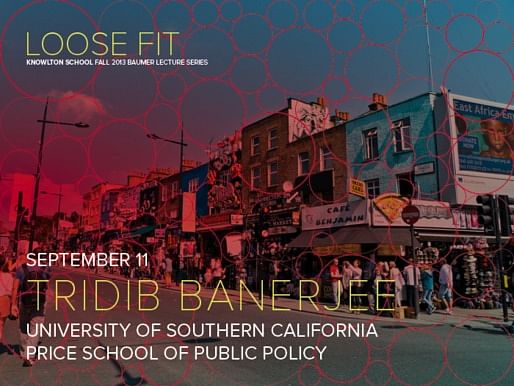

Welcome back everyone. This Wednesday we had speaker Tridib Banjeer join us from USC. Tridib is a Dr of Urban and Regional Planning at the Sol Price School of Public Policy at the University of Southern California. His research over the years has included the relationship of the built environment to social consequences and the involvement of citizens in public space, to name a few. His lecture for the evening was titled “Public Space, Urban Commons, and Urban Design: A Comparative Perspective”.
Delving right into the theme for the lecture we looked at the roles public spaces serve and trends that are affecting these roles. To frame this discussion he presented the saying “Stadtluft macht frei” (Urban air makes you free). Though this old German saying relates to serfs obtaining freedom in the Middle Ages, its application here is to introduce the idea that public spaces, for our consideration, play a role in social experiences, democracy, and freedom. He presented these roles as 4 theories of public space.
The first, Social, is the idea that public spaces are meant for social interaction. The best examples of this would be Central Park in New York or the National Mall in Washington DC.The second, Political, is that public spaces are a realm for political action and the exercising of political rights. Any public protest reinforces this concept, considering the historical march on Washington for African American rights or the recent protests during the Arab Spring and taking place in Istanbul’s Taksim Square. The third, Feminist Theory, establishes the public spaces are an inherent male domain. Examples would be in ancient Greece, where men only would go to the Agora to vote. A more contemporary example is the female donning of the Burka in public. The fourth, Liberal Economic Theory, states that public space is a linking of market and governmental policies. The relationship between the two is a driver for the resultant space. Consider the role that restaurants, shops, and offices play on public space. Examples might be Bryant Park in New York whose immense fame, in part is due to the fashion week that takes place there, along with other year round public and privately funded events.
The next part of his lecture looked at themes that have or are particularly important in todays consideration of public spaces. He framed this as a series of “Narratives of Loss”. He began into the concept of privately owned public space. As a result of either financial or land constraints there has been a trend of seemingly public spaces, used by the public, but which are actually owned by private organizations. This isn’t all a bad thing as many of these space are very nice and well kept. One of the potential issues though is that it becomes an honor and not a right to be there and thus undesirable people can be kicked, even for simple actions like taking pictures. Tridib himself has been asked to leave before. A second loss is the encroachment of the common space by money making ventures. This once again sounds all negative, but it’s not. Consider the recent surge in food trucks in many American cities (certainly Columbus) that have been a great success. Where it becomes problematic is when these public spaces lose their appeal due to a over-influx vendors.
The opposite of encroachment, enclosure, is also an issue that ties back to privately owned public space. The example he referenced was a particular aerial image taking in Rio de Janeiro. What occurred was the city gave away land to a developer directly adjacent to the Favela. What then occurred was the space became walled of and private and then turned in a beautiful country club with a high-rise apartment tower. The juxtaposition of these two is quite startling and it is sad to see publicly owned space (originally) not used for the public good. One other point I wanted to bring forward was the loss of privacy in public spaces. Increasing surveillance trends has resulted in a number of important benefits such as increased security. The caveat to this however is that the body in control of that footage can very quickly know much about you; what therapist you are seeing, your schedule from being away from home, etc. It’s a fine line that has been under much debate in recent years.
Concluding, he brought up challenges for urban design. First is managing the design of the city and the way in which a city grows. There is the ideal, Platonic way in which it is laid out to a very strict plan, referencing Brasília. The manner in which most cities grow however is more Aristotelian which is provincial, up for discussion, and organic; the anti-hero to urban development. Working within a changing urban structure one means to generate public space that he discussed is reclamation. The recent pedestrian pedestrianizing of much of Times Square and the conversion of rail-lines for the Highline are to excellent examples of this.
Overall his talk was enlightening and I feel gave perspective on the role of public spaces and the tasks urban planners and the public will be contending with in the future. Once the video is processed you can find the whole lecture on the Knowlton website (http://knowlton.osu.edu/news-and-events/lectures) and join us next week with Peter Trummer from the University of Innsbruck. Also, he is currently leading a workshop that will conclude this coming week, so keep an eye-out for more on that.
This blog will be a feeder for recent news, events and student work occurring at the Knowlton School at The Ohio State University. Posts will typically center around updates from the school's lecture series, exciting projects from recent student reviews and updates from other school events.



No Comments
Block this user
Are you sure you want to block this user and hide all related comments throughout the site?
Archinect
This is your first comment on Archinect. Your comment will be visible once approved.